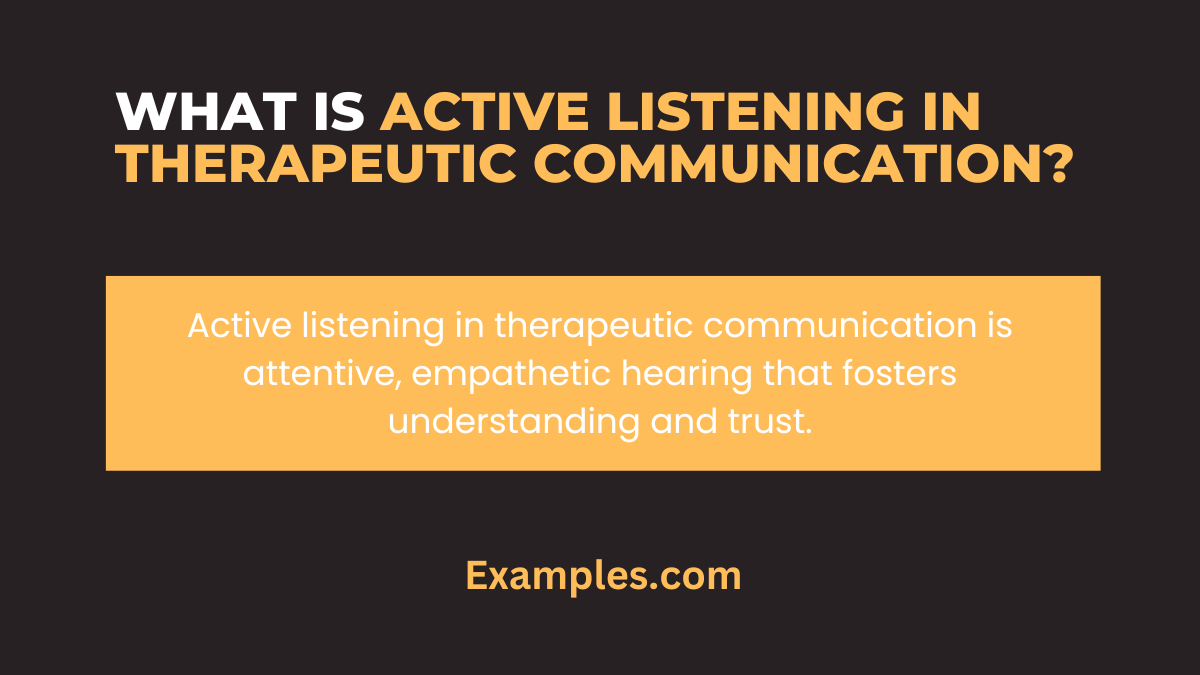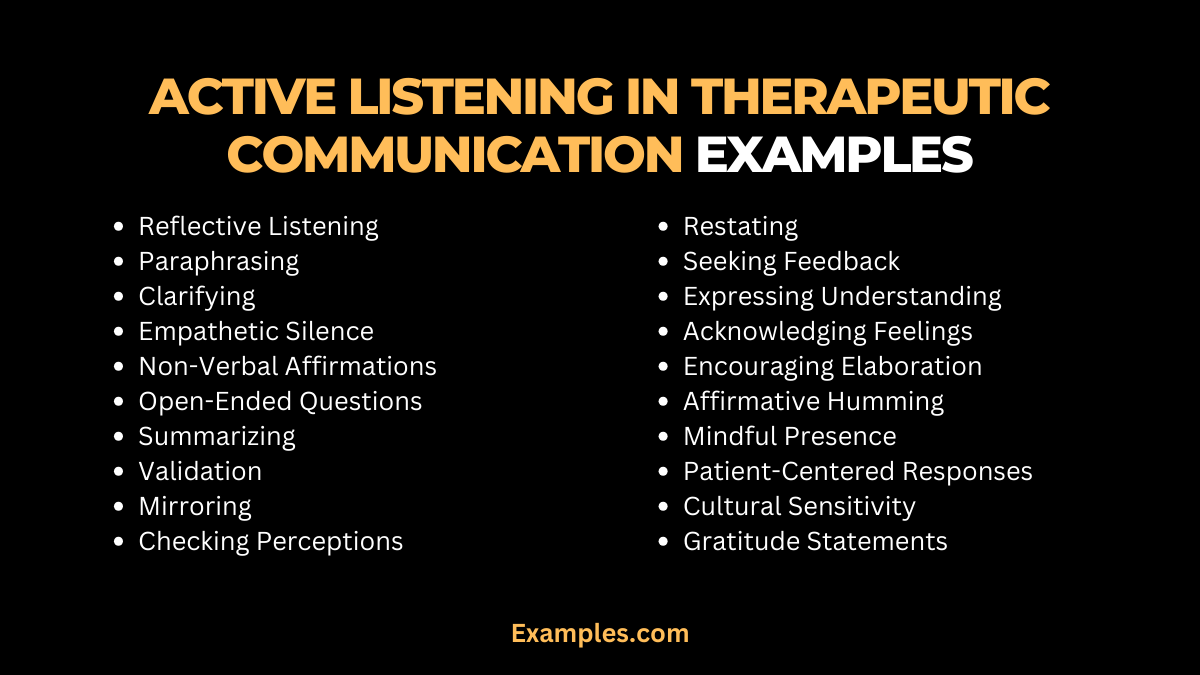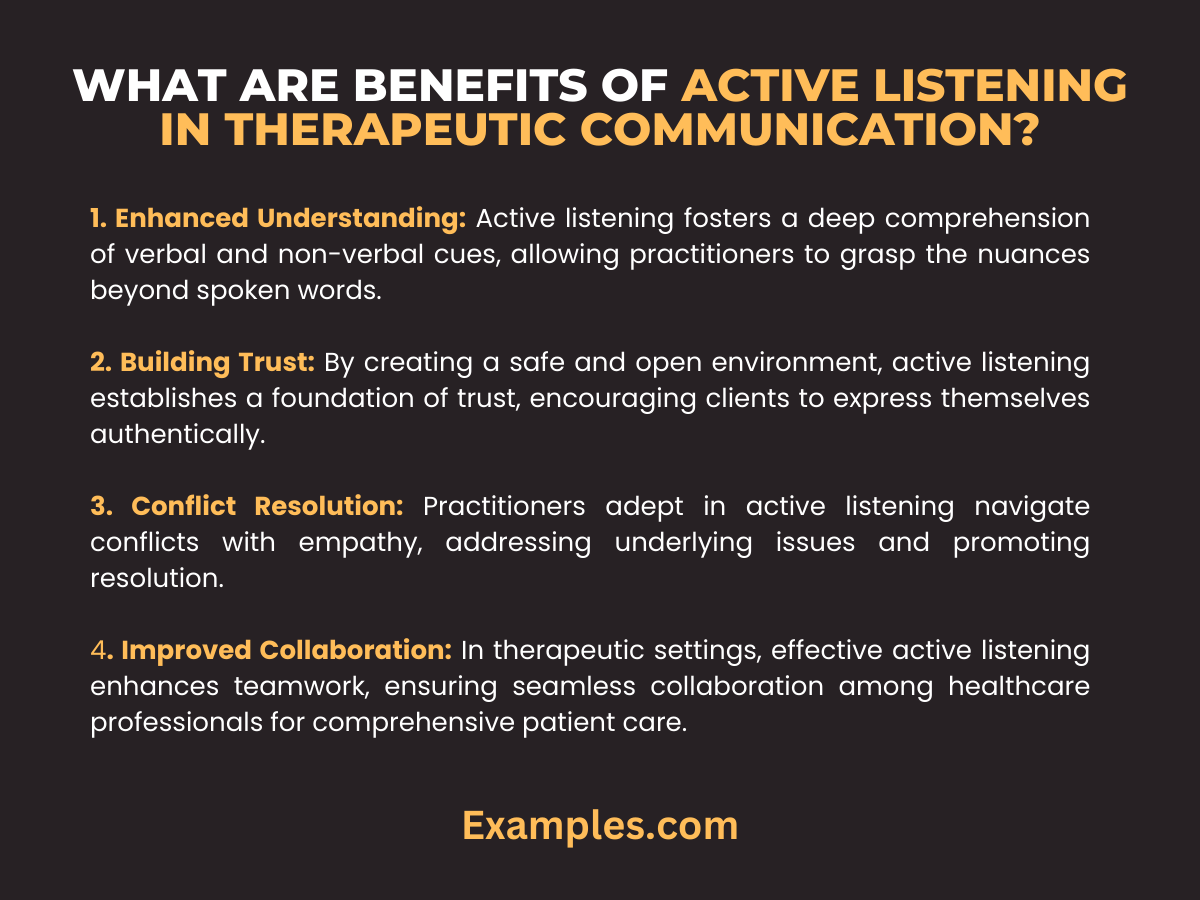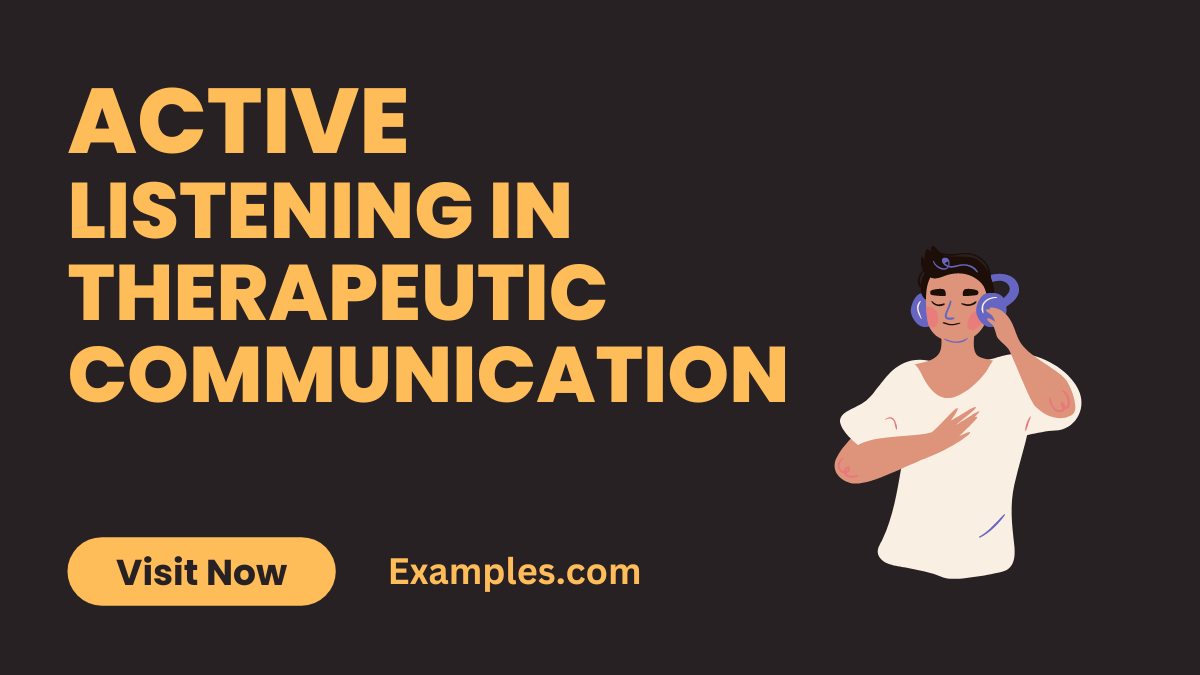Active Listening in Therapeutic Communication – 19+ Examples, How to Improve, Tips
Unlock the transformative realm of therapeutic communication with our comprehensive guide on active listening. Elevate your interpersonal skills as we delve into practical communication examples that showcase the art of truly connecting. From empathetic understanding to fostering trust, we unveil key techniques for effective dialogue. Whether you’re a professional in healthcare or seeking personal growth, this guide provides actionable insights to enhance your communication prowess. Join us on a journey where words become bridges and active listening becomes a powerful catalyst for meaningful connections.
What is Active Listening in Therapeutic Communication?

Active listening in therapeutic communication is a dynamic and engaged form of hearing, emphasizing not just the words spoken, but also the emotions and nuances behind them. It involves offering full attention, responding thoughtfully, and providing feedback, creating an environment of trust and understanding. In simple terms, active listening is more than hearing; it’s about connecting, comprehending, and responding in a way that fosters meaningful and empathetic communication in therapeutic settings.
20 Active Listening in Therapeutic Communication Examples

Enhance your therapeutic communication skills with these 20 active listening examples. Dive into real-life scenarios that showcase the power of attentive engagement. Master the art of understanding emotions, providing feedback, and fostering trust through our carefully curated examples. Elevate your communication game and build stronger connections in therapeutic settings.
- Reflective Listening: Responding with, “It sounds like you’re feeling overwhelmed. Can you share more about that?”
- Paraphrasing: Summarizing, “If I understand correctly, you’re saying…”
- Clarifying: Seeking clarity, “I want to make sure I understand. Are you saying…?”
- Empathetic Silence: Offering a supportive presence without words during moments of distress.
- Non-Verbal Affirmations: Nodding, smiling, or using facial expressions to show understanding.
- Open-Ended Questions: Encouraging dialogue with questions like, “Can you tell me more about that?”
- Summarizing: Concluding a discussion point with a brief recap for clarity.
- Validation: Acknowledging emotions, “It’s okay to feel that way.”
- Mirroring: Reflecting emotions, “I sense that you’re feeling…”
- Checking Perceptions: Confirming understanding, “Am I interpreting this correctly?”
- Restating: Repeating key points to convey understanding.
- Seeking Feedback: Asking, “How does that resonate with you?”
- Expressing Understanding: Saying, “I can imagine that must be difficult for you.”
- Acknowledging Feelings: Recognizing emotions, “It seems like this situation is making you feel…”
- Encouraging Elaboration: Inviting more details, “Tell me more about what led to this feeling.”
- Affirmative Humming: Using subtle vocal cues to show attentiveness.
- Mindful Presence: Being fully engaged without distractions during conversations.
- Patient-Centered Responses: Tailoring communication to the individual’s needs and preferences.
- Cultural Sensitivity: Considering cultural nuances in responses.
- Gratitude Statements: Expressing appreciation for sharing, “Thank you for opening up about this.”
Active Listening in Therapeutic Communication Examples for Students
Empower students with effective communication tools through active listening. This guide provides practical examples tailored for academic settings, helping students cultivate empathetic dialogues, foster understanding, and enrich interpersonal relationships within the educational environment.
- Clarifying Academic Concerns: “Can you clarify your question about the assignment? I want to ensure I address your concerns accurately.”
- Reflective Feedback on Presentations: “I heard your points on climate change. Your passion truly came through. What inspired your interest in this topic?”
- Acknowledging Stress: “I noticed you seemed tense during the exam. Is there anything on your mind you’d like to talk about?”
- Active Participation Encouragement: “Your input in class discussions is valuable. How can I support your involvement even more?”
- Expressing Empathy for Challenges: “I understand balancing studies can be tough. How can we work together to make it more manageable?”
- Feedback on Team Projects: “In your team presentation, I observed strong collaboration. What strategies contributed to your group’s success?”
- Addressing Personal Growth: “I’ve noticed your improvement in time management. How did you develop these effective study habits?”
- Inquiring about Goals: “Your career aspirations are intriguing. What steps can we take to align your coursework with your future plans?”
- Encouraging Peer Support: “I’ve observed your supportiveness to classmates. How can we foster a more supportive learning environment together?”
- Clarifying Expectations: “I sensed some confusion about the assignment. Let’s clarify the expectations together. What are your thoughts?”
Active Listening in Therapeutic Communication Examples in Nursing
Navigate the intricate world of healthcare with active listening examples tailored for nursing professionals. This resource equips nurses with communication skills vital for patient care, encouraging compassionate understanding, and fostering therapeutic connections.
- Empathetic Bedside Manner: “I sense your discomfort. Let’s discuss your pain levels so we can adjust your care plan accordingly.”
- Clarifying Medication Concerns: “Your questions about the prescribed medications are important. What specific details would you like me to clarify?”
- Acknowledging Patient Anxiety: “I observed signs of anxiety during the procedure. Can you share your concerns so we can address them together?”
- Active Listening during Patient History: “I’m hearing about your medical history. Is there anything else you’d like to add or emphasize?”
- Expressing Understanding of Diagnosis: “Your diagnosis can be overwhelming. How can I support you emotionally as we navigate your treatment plan?”
- Feedback on Treatment Options: “I’ve considered your preferences for treatment. What factors are most important to you in making this decision?”
- Addressing Family Concerns: “I noticed your family’s involvement is crucial to you. How can we include them effectively in your care plan?”
- Encouraging Patient Autonomy: “Your input matters in decision-making. What information can I provide to help you make informed choices about your care?”
- Clarifying Discharge Instructions: “I want to ensure you understand your post-discharge care. What aspects of the instructions do you find confusing?”
- Supporting Emotional Well-being: “I sensed some distress during our conversation. How can we address any emotional challenges you’re facing alongside your physical health?”
How to Improve Active Listening in Therapeutic Communication?
Enhance your active listening skills by staying present, maintaining eye contact, and avoiding distractions. Practice reflective responses, paraphrasing, and non-verbal affirmations. Seek feedback to continually refine your technique, creating a foundation for meaningful connections in therapeutic communication.
How does Active Listening in Therapeutic Communication build Relationships?
Active listening fosters trust and understanding, laying the groundwork for strong therapeutic relationships. By acknowledging emotions, offering support, and engaging empathetically, practitioners create a safe space for clients to express themselves openly, deepening the connection and promoting healing.
What are Benefits of Active Listening in Therapeutic Communication?

- Enhanced Understanding: Active listening fosters a deep comprehension of verbal and non-verbal cues, allowing practitioners to grasp the nuances beyond spoken words.
- Building Trust: By creating a safe and open environment, active listening establishes a foundation of trust, encouraging clients to express themselves authentically.
- Conflict Resolution: Practitioners adept in active listening navigate conflicts with empathy, addressing underlying issues and promoting resolution.
- Improved Collaboration: In therapeutic settings, effective active listening enhances teamwork, ensuring seamless collaboration among healthcare professionals for comprehensive patient care.
- Patient Satisfaction: Attentive communication leads to higher patient satisfaction, elevating the quality of care and promoting positive therapeutic outcomes.
Tips for Effective Active Listening in Therapeutic Communications
- Stay Present: Eliminate distractions for focused engagement.
- Reflective Responses: Mirror and validate emotions expressed.
- Open-Ended Questions: Encourage expansive dialogue.
- Non-Verbal Cues: Utilize affirmative gestures for reassurance.
- Empathetic Silence: Allow moments for reflection.
- Summarization: Recap key points for clarity.
- Cultural Sensitivity: Understand diverse communication styles.
- Patient-Centered Approach: Tailor interactions to individual needs.
- Continuous Feedback: Seek input to refine communication strategies.
- Mindful Presence: Be fully engaged, fostering a trusting therapeutic environment.
In conclusion, mastering active listening in therapeutic communication is pivotal for cultivating empathetic connections. This complete guide has unraveled examples and practical strategies to enhance your skills. From reflective responses to cultural sensitivity, embrace the power of attentive engagement. Elevate your communication prowess, fostering meaningful relationships that transcend words, and navigate the intricacies of therapeutic dialogue with confidence and compassion.
Active Listening in Therapeutic Communication – 19+ Examples, How to Improve, Tips

Unlock the transformative realm of therapeutic communication with our comprehensive guide on active listening. Elevate your interpersonal skills as we delve into practical communication examples that showcase the art of truly connecting. From empathetic understanding to fostering trust, we unveil key techniques for effective dialogue. Whether you’re a professional in healthcare or seeking personal growth, this guide provides actionable insights to enhance your communication prowess. Join us on a journey where words become bridges and active listening becomes a powerful catalyst for meaningful connections.
What is Active Listening in Therapeutic Communication?

Active listening in therapeutic communication is a dynamic and engaged form of hearing, emphasizing not just the words spoken, but also the emotions and nuances behind them. It involves offering full attention, responding thoughtfully, and providing feedback, creating an environment of trust and understanding. In simple terms, active listening is more than hearing; it’s about connecting, comprehending, and responding in a way that fosters meaningful and empathetic communication in therapeutic settings.
20 Active Listening in Therapeutic Communication Examples

Enhance your therapeutic communication skills with these 20 active listening examples. Dive into real-life scenarios that showcase the power of attentive engagement. Master the art of understanding emotions, providing feedback, and fostering trust through our carefully curated examples. Elevate your communication game and build stronger connections in therapeutic settings.
Reflective Listening: Responding with, “It sounds like you’re feeling overwhelmed. Can you share more about that?”
Paraphrasing: Summarizing, “If I understand correctly, you’re saying…”
Clarifying: Seeking clarity, “I want to make sure I understand. Are you saying…?”
Empathetic Silence: Offering a supportive presence without words during moments of distress.
Non-Verbal Affirmations: Nodding, smiling, or using facial expressions to show understanding.
Open-Ended Questions: Encouraging dialogue with questions like, “Can you tell me more about that?”
Summarizing: Concluding a discussion point with a brief recap for clarity.
Validation: Acknowledging emotions, “It’s okay to feel that way.”
Mirroring: Reflecting emotions, “I sense that you’re feeling…”
Checking Perceptions: Confirming understanding, “Am I interpreting this correctly?”
Restating: Repeating key points to convey understanding.
Seeking Feedback: Asking, “How does that resonate with you?”
Expressing Understanding: Saying, “I can imagine that must be difficult for you.”
Acknowledging Feelings: Recognizing emotions, “It seems like this situation is making you feel…”
Encouraging Elaboration: Inviting more details, “Tell me more about what led to this feeling.”
Affirmative Humming: Using subtle vocal cues to show attentiveness.
Mindful Presence: Being fully engaged without distractions during conversations.
Patient-Centered Responses: Tailoring communication to the individual’s needs and preferences.
Cultural Sensitivity: Considering cultural nuances in responses.
Gratitude Statements: Expressing appreciation for sharing, “Thank you for opening up about this.”
Active Listening in Therapeutic Communication Examples for Students
Empower students with effective communication tools through active listening. This guide provides practical examples tailored for academic settings, helping students cultivate empathetic dialogues, foster understanding, and enrich interpersonal relationships within the educational environment.
Clarifying Academic Concerns: “Can you clarify your question about the assignment? I want to ensure I address your concerns accurately.”
Reflective Feedback on Presentations: “I heard your points on climate change. Your passion truly came through. What inspired your interest in this topic?”
Acknowledging Stress: “I noticed you seemed tense during the exam. Is there anything on your mind you’d like to talk about?”
Active Participation Encouragement: “Your input in class discussions is valuable. How can I support your involvement even more?”
Expressing Empathy for Challenges: “I understand balancing studies can be tough. How can we work together to make it more manageable?”
Feedback on Team Projects: “In your team presentation, I observed strong collaboration. What strategies contributed to your group’s success?”
Addressing Personal Growth: “I’ve noticed your improvement in time management. How did you develop these effective study habits?”
Inquiring about Goals: “Your career aspirations are intriguing. What steps can we take to align your coursework with your future plans?”
Encouraging Peer Support: “I’ve observed your supportiveness to classmates. How can we foster a more supportive learning environment together?”
Clarifying Expectations: “I sensed some confusion about the assignment. Let’s clarify the expectations together. What are your thoughts?”
Active Listening in Therapeutic Communication Examples in Nursing
Navigate the intricate world of healthcare with active listening examples tailored for nursing professionals. This resource equips nurses with communication skills vital for patient care, encouraging compassionate understanding, and fostering therapeutic connections.
Empathetic Bedside Manner: “I sense your discomfort. Let’s discuss your pain levels so we can adjust your care plan accordingly.”
Clarifying Medication Concerns: “Your questions about the prescribed medications are important. What specific details would you like me to clarify?”
Acknowledging Patient Anxiety: “I observed signs of anxiety during the procedure. Can you share your concerns so we can address them together?”
Active Listening during Patient History: “I’m hearing about your medical history. Is there anything else you’d like to add or emphasize?”
Expressing Understanding of Diagnosis: “Your diagnosis can be overwhelming. How can I support you emotionally as we navigate your treatment plan?”
Feedback on Treatment Options: “I’ve considered your preferences for treatment. What factors are most important to you in making this decision?”
Addressing Family Concerns: “I noticed your family’s involvement is crucial to you. How can we include them effectively in your care plan?”
Encouraging Patient Autonomy: “Your input matters in decision-making. What information can I provide to help you make informed choices about your care?”
Clarifying Discharge Instructions: “I want to ensure you understand your post-discharge care. What aspects of the instructions do you find confusing?”
Supporting Emotional Well-being: “I sensed some distress during our conversation. How can we address any emotional challenges you’re facing alongside your physical health?”
How to Improve Active Listening in Therapeutic Communication?
Enhance your active listening skills by staying present, maintaining eye contact, and avoiding distractions. Practice reflective responses, paraphrasing, and non-verbal affirmations. Seek feedback to continually refine your technique, creating a foundation for meaningful connections in therapeutic communication.
How does Active Listening in Therapeutic Communication build Relationships?
Active listening fosters trust and understanding, laying the groundwork for strong therapeutic relationships. By acknowledging emotions, offering support, and engaging empathetically, practitioners create a safe space for clients to express themselves openly, deepening the connection and promoting healing.
What are Benefits of Active Listening in Therapeutic Communication?

Enhanced Understanding: Active listening fosters a deep comprehension of verbal and non-verbal cues, allowing practitioners to grasp the nuances beyond spoken words.
Building Trust: By creating a safe and open environment, active listening establishes a foundation of trust, encouraging clients to express themselves authentically.
Conflict Resolution: Practitioners adept in active listening navigate conflicts with empathy, addressing underlying issues and promoting resolution.
Improved Collaboration: In therapeutic settings, effective active listening enhances teamwork, ensuring seamless collaboration among healthcare professionals for comprehensive patient care.
Patient Satisfaction: Attentive communication leads to higher patient satisfaction, elevating the quality of care and promoting positive therapeutic outcomes.
Tips for Effective Active Listening in Therapeutic Communications
Stay Present: Eliminate distractions for focused engagement.
Reflective Responses: Mirror and validate emotions expressed.
Open-Ended Questions: Encourage expansive dialogue.
Non-Verbal Cues: Utilize affirmative gestures for reassurance.
Empathetic Silence: Allow moments for reflection.
Summarization: Recap key points for clarity.
Cultural Sensitivity: Understand diverse communication styles.
Patient-Centered Approach: Tailor interactions to individual needs.
Continuous Feedback: Seek input to refine communication strategies.
Mindful Presence: Be fully engaged, fostering a trusting therapeutic environment.
In conclusion, mastering active listening in therapeutic communication is pivotal for cultivating empathetic connections. This complete guide has unraveled examples and practical strategies to enhance your skills. From reflective responses to cultural sensitivity, embrace the power of attentive engagement. Elevate your communication prowess, fostering meaningful relationships that transcend words, and navigate the intricacies of therapeutic dialogue with confidence and compassion.


